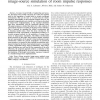Free Online Productivity Tools
i2Speak
i2Symbol
i2OCR
iTex2Img
iWeb2Print
iWeb2Shot
i2Type
iPdf2Split
iPdf2Merge
i2Bopomofo
i2Arabic
i2Style
i2Image
i2PDF
iLatex2Rtf
Sci2ools
149
click to vote
TASLP
2010
2010
Diffuse Reverberation Model for Efficient Image-Source Simulation of Room Impulse Responses
Abstract-- In many research fields of engineering and acoustics, the image-source model represents one of the most popular tools for the simulation of sound fields in virtual reverberant environments. This can be seen as a result from the relative simplicity and flexibility of this particular method. However, the associated computational costs constitute a well known drawback of image-source implementations, as the required simulation times grow exponentially with the considered reflection order. This paper proposes a method that allows for a fast synthesis of room impulse responses according to the image-source technique. This is achieved by modeling the diffuse reverberation tail as decaying random noise, where the decay envelope for the considered acoustic environment is determined according to a recently proposed method for the prediction of energy decay curves in image-source simulations. The diffuse reverberation model presented in this paper thus produces impulse responses that ...
| Added | 21 May 2011 |
| Updated | 21 May 2011 |
| Type | Journal |
| Year | 2010 |
| Where | TASLP |
| Authors | Eric A. Lehmann, Anders M. Johansson |
Comments (0)

